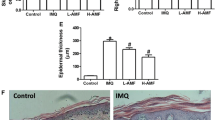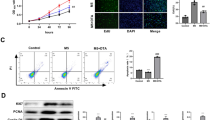Abstract
Peptide T (PT), an octapeptide fragment located in the V2 region of the HIV-1 gp120-coating protein, appears to be beneficial in the treatment of psoriasis. Our previous investigations suggest that keratinocytes play a key role in conditioning the therapeutic effects of PT in psoriasis. The aim of this study was to explore the effects of PT and the peptidomimetic natural products, Dhurrin and Prunasin, on the expression of the IL-6, IL-8, IL-23, HSP70 and ICAM-1 on IFN-γ and TNF-α-NHEK activated cells. Moreover, we analysed the interference of PT and its analogues through STAT-3 activation. Our results show that the analogues tested exhibit the beneficial biological effects of PT, suggesting the primary role of keratinocytes upon which PT and the peptidomimetics act directly, by reducing proinflammatory responses. Its reduction appears to be important for therapeutic approach in psoriasis pathogenesis.






Similar content being viewed by others
References
Pert, C.B., and M.R. Ruff. 1986. Peptide t[4–8]: a pentapeptide sequence in the aids virus envelope which blocks infectivity is essentially conserved across nine isolates. Clinical Neuropharmacology 9(4): 482–484.
Yang, T.C., J. Rendell, W. Gulliverb, and V. Bootha. 2009. Peptide T exhibits a well-defined structure in fluorinated solvent at low temperature. Journal of Peptide Science 15: 818–823.
Marcusson, J.A., D. Lazega, C.B. Pert, M.R. Ruff, K.G. Sundquist, and L. Wetterberg. 1989. Peptide T and psoriasis. Acta Dermato Venereol Supplement (Stockh) 146: 117–121.
Raychaudhuri, S.K., S.P. Raychaudhuri, and E.M. Farber. 1998. Anti-chemotactic activities of peptide-T: a possible mechanism of actions for its therapeutic effects on psoriasis. International Journal of Immunopharmacology 20(11): 661–667.
Baroni, A., I. Paoletti, R. Greco, R.A. Satriano, E. Ruocco, M.A. Tufano, et al. 2005. Immunomodulatory effects of a set of amygdalin analogues on human keratinocytes cells. Experimental Dermatology 14(11): 854–859.
Tufano, M.A., R. Greco, I. Paoletti, G. Donnarumma, N. Canozo, and A. Baroni. 2002. Immunomodulatory effects of peptide T on human keratinocyte cells. The British Journal of Dermatology 147(4): 663–669.
Tohyama, M., Y. Hanakawa, Y. Shirakata, et al. 2009. IL-17 and IL-22 mediate IL-20 subfamily cytokine production in cultured keratinocytes via increased IL-22 receptor expression. European Journal of Immunology 39: 2779–2788.
Barna, M., F.G. Snijdewint, F.L. van der Heijden, J.D. Bos, and M.L. Kapsenberg. 1994. Characterization of lesional psoriatic skin T lymphocyte clones. Acta Derm Venereol Suppl (Stockh) 186: 9–11.
Albanesi, C., C. Scarponi, S. Sebastiani, A. Cavani, M. Federici, S. Sozzani, et al. 2001. A cytokine-to-chemokine axis between T lymphocytes and keratinocytes can favor Th1 cell accumulation in chronic inflammatory skin diseases. Journal of Leukocyte Biology 70(4): 617–623.
Federici, M., M.L. Giustizieri, C. Scarponi, G. Girolomoni, and C. Albanesi. 2002. Impaired IFN-γ-dependent inflammatory responses in human keratinocytes overexpressing the suppressor of cytokine signaling 1. The Journal of Immunology 169: 434–442.
Hongqin, T., L. Xinyu, G. Heng, X. Lanfang, W. Yongfang, and S. Shasha. 2011. Triptolide inhibits IFN-γ signaling via the Jak/STAT. Pathway in HaCat keratinocytes. Phytotherapy Research 25: 1678–1685.
Wegenka, U.M., C. Lütticken, J. Buschmann, et al. 1994. The interleukin-6-activated acute-phase response factor is antigenically and functionally related to members of the signal transducer and activator of transcription (STAT) family. Molecular and Cellular Biology 14(5): 3186–3196.
Zhong, Z., Z. Wen, and J.E. Darnell Jr. 1994. Stat3: a STAT family member activated by tyrosine phosphorylation in response to epidermal growth factor and interleukin-6. Science 264(5155): 95–98.
Caldenhoven, E., T. van Dijk, J.A. Raaijmakers, J.W. Lammers, L. Koenderman, and R.P. De Groot. 1995. Activation of the STAT3/acute phase response factor transcription factor by interleukin-5. The Journal of Biological Chemistry 270(43): 25778–25784.
Miyoshi, K., M. Takaishi, K. Nakajima, et al. 2011. Stat3 as a therapeutic target for the treatment of psoriasis: a clinical feasibility study with STA-21, a Stat3 inhibitor. The Journal of Investigative Dermatology 131(1): 108–117.
Wen, Z., Z. Zhong, and J.E.J. Darnell. 1995. Maximal activation of transcription by Stat1 and Stat3 requires both tyrosine and serine phosphorylation. Cell 82: 241–250.
Yuan, Z.L., Y.J. Guan, D. Chatterjee, and Y.E. Chin. 2005. Stat3 dimerization regulated by reversible acetylation of a single lysine residue. Science 307: 269–273.
Sestito, R., S. Madonna, C. Scarponi, et al. 2011. STAT3-dependent effects of IL-22 in human keratinocytes are counterregulated by sirtuin 1 through a direct inhibition of STAT3 acetylation. The FASEB Journal Research Communication 25(3): 916–927.
Wang, D., B. Eiz-Vesper, J. Zeitvogel, R. Dressel, T. Werfel, and M. Wittmann. 2011. Human keratinocytes release high levels of inducible heat shock protein 70 that enhances peptide uptake. Experimental Dermatology 20(8): 637–641.
Curry, J.L., J.Z. Qin, B. Bonish, R. Carrick, P. Bacon, J. Panella, et al. 2003. Innate immune-related receptors in normal and psoriatic skin. Archives of Pathology & Laboratory Medicine 127(2): 178–186.
Boyman, O., C. Conrad, C. Dudli, E. Kielhorn, B.J. Nickoloff, and F.O. Nestle. 2005. Activation of dendritic antigen-presenting cells expressing common heat shock protein receptor CD91 during induction of psoriasis. The British Journal of Dermatology 152(6): 1211–1218.
Fang, S., F. Zeng, and Q. Guo. 2008. Comparative proteomics analysis of cytokeratin and involucrin expression in lesions from patients with systemic lupus erythematosus. Acta Biochimica et Biophysica Sinica 40(12): 989–995.
Pockley, A.G., M. Muthana, and S.K. Calderwood. 2008. The dual immunoregulatory roles of stress proteins. Trends in Biochemical Sciences 33(2): 71–79.
Chan, J.R., W. Blumenschein, E. Murphy, et al. 2006. IL-23 stimulates epidermal hyperplasia via TNF and IL-20R2-dependent mechanisms with implications for psoriasis pathogenesis. The Journal of Experimental Medicine 203: 2577–2587.
Reddy, M., C. Davis, J. Wong, P. Marsters, C. Pendley, and U. Prabhakar. 2007. Modulation of CLA, IL-12R, CD40L, and IL-2Ra expression and inhibition of IL-12- and IL-23-induced cytokine secretion by CNTO 1275. Cellular Immunology 247: 1–11.
Tang, C., S. Chen, H. Qian, and W. Huang. 2012. Interleukin-23: as a drug target for autoimmune inflammatory diseases. Immunology 135(2): 112–124.
Kanda, N., and S. Watanabe. 2008. IL-12, IL-23, and IL-27 enhance human beta-defensin-2 production in human keratinocytes. European Journal of Immunology 38(5): 1287–1296.
Kanai, Y., T. Satoh, K. Igawa, and H. Yokozeki. 2012. Impaired expression of Tim-3 on Th17 and Th1 cells in psoriasis. Acta Derm Venereol Suppl (Stockh) 92: 367–371.
Parham, C., M. Chirica, J. Timans, et al. 2002. A receptor for the heterodimeric cytokine IL-23 is composed of IL-12Rβ1 and a novel cytokine receptor subunit, IL-23R. The Journal of Immunology 168: 5699–5708.
Coimbra, S., A. Figueiredo, E. Castro, P. Rocha-Pereira, and A. Santos-Silva. 2012. The roles of cells and cytokines in the pathogenesis of psoriasis. International Journal of Dermatology 51(4): 389–395.
Tonel, G., C. Conrad, U. Laggner, et al. 2010. Cutting edge: a critical functional role for IL-23 in psoriasis. The Journal of Immunology 185: 5688–5691.
Victor, F.C., and A.B. Gottlieb. 2002. TNF-alpha and apoptosis: implications for the pathogenesis and treatment of psoriasis. Journal of Drugs in Dermatology 1(3): 264–275.
Bito, T., Roy, S., Sen, C.K., Packer L. 2000. Pine bark extract pycnogenol downregulates IFN-gamma-induced adhesion of T cells to human keratinocytes by inhibiting inducible ICAM-1 expression. Free Radical Biology and Medicine 28(2):219–27
Jarvis, M., Marzolini, M., Wang, X.N., Jackson, G., Sviland, L., Dickinson, A.M. 2003. Heat shock protein 70: correlation of expression with degree of graft-versus-host response and clinical graft-versus-host disease. Transplantation 76(5):849–53
Novota, P., L. Sviland, S. Zinöcker, P. Stocki, Y. Balavarca, H. Bickeböller, et al. 2008. Correlation of Hsp70-1 and Hsp70-2 gene expression with the degree of graft-versus-host reaction in a rat skin explant model. Transplantation 85(12): 1809–1816.
Baroni, A., I. Paoletti, E. Ruocco, M. Agozzino, M.A. Tufano, and G. Donnarumma. 2004. Possible role of Malassezia furfur in psoriasis: modulation of TGF-beta1, integrin, and HSP70 expression in human keratinocytes and in the skin of psoriasis-affected patients. Journal of Cutaneous Pathology 31(1): 35–42.
Bayramgürler, D., S.K. Ozkara, R. Apaydin, C. Erçin, and N. Bilen. 2004. Heat shock proteins 60 and 70 expression of cutaneous lichen planus: comparison with normal skin and psoriasis vulgaris. Journal of Cutaneous Pathology 31(9): 586–594.
Ghoreishi, M., I. Katayama, H. Yokozeki, and K. Nishioka. 1993. Analysis of 70 KD heat shock protein (HSP70) expression in the lesional skin of lupus erythematosus (LE) and LE related diseases. The Journal of Dermatology 20(7): 400–405.
Villalobos-Hurtado, R., S.H. Sánchez-Rogriguez, E. Avalos-Díaz, and R. Herrera-Esparza. 2003. Possible role of Hsp70 in autoantigen shuttling to the dermo-epidermal junction in systemic lupus erythematosus. Reumatismo 55(3): 155–158.
Yokozeki, H., Ghoreishi, M., Takagawa, S., Takayama, K., Satoh, T., Katayama, I., Takeda, K., Akira, S., Nishioka, K. 2000. Signal transducer and activator of transcription 6 is essential in the induction of contact hypersensitivity. Journal of Experimental Medicine 191(6):995–1004
Author information
Authors and Affiliations
Corresponding author
Additional information
The first two authors Iole Paoletti and Vincenza De Gregorio equally contributed to this work.
Rights and permissions
About this article
Cite this article
Paoletti, I., De Gregorio, V., Baroni, A. et al. Amygdalin Analogues Inhibit IFN-γ Signalling and Reduce the Inflammatory Response in Human Epidermal Keratinocytes. Inflammation 36, 1316–1326 (2013). https://doi.org/10.1007/s10753-013-9670-7
Published:
Issue Date:
DOI: https://doi.org/10.1007/s10753-013-9670-7




